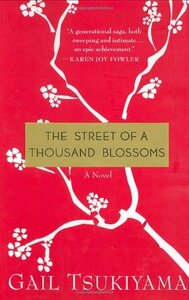Take a photo of a barcode or cover
This fine novel follows two Japanese families over three decades - from 1930s to 1960s. Interesting detail on sumo wrestling, Noh theater and the effects of the war. Tsukiyama's writing is poetic.
There were many things I loved about this book because I have a special interest in Japan right now. I loved how she threw in Japanese words on a regular basis and how I learned more about life in Japan before during and after WWII. Unfortunately, the book left me too sad. I didn't care for the ending. I actually fell asleep right after I read the last page and had a dream that all these bad things were happening to a family I know and even in the dream I was saying, "why does everything keep happening to them?" Sure I have read other books with more sad/tragic happenings, but that doesn't appeal to me. I would rather see the triumph play out!
For the most part, an excellent read. There were just a few parts that dragged just a little.
Not as good as some of her other books. I thought it was a bit overdone that both brothers go into unusual occupations. I think the story would have been better if one brother had a more conventional occupation.
The parts about life in Japan during the second world war were the best.
The parts about life in Japan during the second world war were the best.
It was okay, I think the characters never really felt fully fleshed out and I didn't really care for most of them, aside from maybe two characters
adventurous
emotional
funny
hopeful
informative
inspiring
mysterious
reflective
sad
tense
medium-paced
Plot or Character Driven:
A mix
Strong character development:
Yes
Loveable characters:
Yes
Diverse cast of characters:
Yes
Flaws of characters a main focus:
Complicated
emotional
inspiring
sad
slow-paced
Plot or Character Driven:
Character
Strong character development:
Yes
Loveable characters:
Complicated
Diverse cast of characters:
Complicated
Flaws of characters a main focus:
No
A slow read, but a intensely emotional and necessary journey through various characters lives. Very well written (with my only problem being the random use of Japanese for common words - "hai" instead of yes).
Graphic: Alcoholism, Death, Homophobia, Grief
I really enjoyed the author's style of writing and am looking forward to reading more books by her. I felt like I was right there with all her characters through their grief, their joy, and even just the every day moments that make up life.
I didn't love this as much as others. It was very long and honestly dragged quite a bit. I did finish it and found it sufficiently entertaining, but I wasn't moved by it.
People love these generational books, especially when they have a cultural aspect. This definitely gives you a glimpse into cultural aspects and I found the sumo portion quite interesting, but it wasn't enough for me.
People love these generational books, especially when they have a cultural aspect. This definitely gives you a glimpse into cultural aspects and I found the sumo portion quite interesting, but it wasn't enough for me.
In this WWII- and post-war-era story that takes place in Japan, two orphaned brothers were growing up with their grandparents. Tall, strong Hiroshi is drawn to the tradition of sumo, while younger, sensitive Kenji wants to be an artisan and create masks for the Noh theater. When the war hits, their plans are put on hold.
This sweeping saga covers 30 years and several parts of Kenji and Hiroshi's eventual families. Gail Tsukiyama, who is part Japanese and part Chinese, paints a clear picture of what it was like to live in Japan during the war. For example, I wasn't aware that Japan had a brutal military police similar to the Stazi, called the Kempeitai. During the bombing raids, all the Japanese had to protect themselves were hand-dug, flimsy bomb shelters in their yards, which were highly ineffective and exposed them to the constant bombings. At the same time that the Japanese military was carrying out horrific abuses and terror throughout Asia, the everyday Japanese people, many of whom did not support the war but could not say so publicly, were suffering as well.
Eventually after the war, Japan began to rebuild itself, and Kenji and Hiroshi were able to pursue their personal passions. They both got married, and Kenji rebuilds his relationship with his Noh mask sensei, who had escaped to the mountains during the war. Much of this book is very sad, as war-time stories often are. Because of my fondness for Japan, I enjoyed learning more about sumo and Noh theater, and perhaps might have a greater appreciation than other readers for the Japanese language and culture woven so artistically through this book.
It doesn't move particularly quickly, but it's beautifully told. It's more of an artistic story than a gripping tale. Kenji and Hiroshi's grandparents are fascinating characters, although I would have liked to have better understood Haru and Aki, daughters of Hiroshi's sumo master. Aki, in particular, was an enigma...both girls were traumatized by what they saw in the war, and Aki never really recovered from this trauma. I also would have liked to know modern, independent Mika (Kenji's wife) better...she was another mystery. She represented a new type of woman in Japan, but how did she come to be that way? We never find out.
For someone who usually writes such strong female characters (I greatly enjoyed Tsukiyama's Women of the Silk and The Language of Threads), I'm surprised that her female characters were lacking substance.
The Street of a Thousand Blossoms is about a changing Japan, and tells stories of how the Japanese were forced to adopt new ways of life and new forms of culture (such as western dress). In spite of modernization, Japan still clings to many forms of its traditional culture, more than most industrialized countries, in fact. For example, women are still not allowed to enter the sumo ring, for fear that the "unclean" women would pollute it with their presence.
I enjoyed this book, but it was not my favorite of Tsukiyama's. I learned a lot of new information about Japan, but I think richer information about the female characters would have made it so much stronger.
This sweeping saga covers 30 years and several parts of Kenji and Hiroshi's eventual families. Gail Tsukiyama, who is part Japanese and part Chinese, paints a clear picture of what it was like to live in Japan during the war. For example, I wasn't aware that Japan had a brutal military police similar to the Stazi, called the Kempeitai. During the bombing raids, all the Japanese had to protect themselves were hand-dug, flimsy bomb shelters in their yards, which were highly ineffective and exposed them to the constant bombings. At the same time that the Japanese military was carrying out horrific abuses and terror throughout Asia, the everyday Japanese people, many of whom did not support the war but could not say so publicly, were suffering as well.
Eventually after the war, Japan began to rebuild itself, and Kenji and Hiroshi were able to pursue their personal passions. They both got married, and Kenji rebuilds his relationship with his Noh mask sensei, who had escaped to the mountains during the war. Much of this book is very sad, as war-time stories often are. Because of my fondness for Japan, I enjoyed learning more about sumo and Noh theater, and perhaps might have a greater appreciation than other readers for the Japanese language and culture woven so artistically through this book.
It doesn't move particularly quickly, but it's beautifully told. It's more of an artistic story than a gripping tale. Kenji and Hiroshi's grandparents are fascinating characters, although I would have liked to have better understood Haru and Aki, daughters of Hiroshi's sumo master. Aki, in particular, was an enigma...both girls were traumatized by what they saw in the war, and Aki never really recovered from this trauma. I also would have liked to know modern, independent Mika (Kenji's wife) better...she was another mystery. She represented a new type of woman in Japan, but how did she come to be that way? We never find out.
For someone who usually writes such strong female characters (I greatly enjoyed Tsukiyama's Women of the Silk and The Language of Threads), I'm surprised that her female characters were lacking substance.
The Street of a Thousand Blossoms is about a changing Japan, and tells stories of how the Japanese were forced to adopt new ways of life and new forms of culture (such as western dress). In spite of modernization, Japan still clings to many forms of its traditional culture, more than most industrialized countries, in fact. For example, women are still not allowed to enter the sumo ring, for fear that the "unclean" women would pollute it with their presence.
I enjoyed this book, but it was not my favorite of Tsukiyama's. I learned a lot of new information about Japan, but I think richer information about the female characters would have made it so much stronger.






